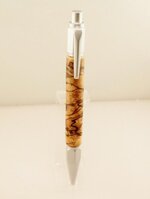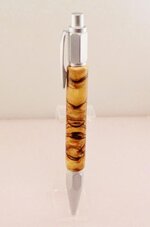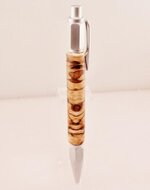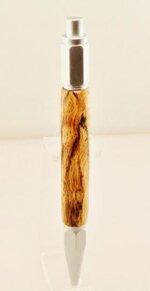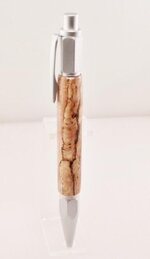plantman
Member
Usualy when I buy blanks from someone, I ask for the wildest, narlyest, knotyest, punkyest grain they have. I like something a little different. This pen is from some Mineral Stained White Oak that Steeve sent me several days ago. The blanks are cut across the grain, giving you end grain the length of your blank. Not very stable to work with !! But, if done carefully, makes a very interesting grain pattern. This is the method I used to turn this blank, and would use for any end grain or realy funky burl. Cut the blank about 1/2" longer than your tube. Cover the entire blank in thin CA, and let it soak in for a little while before spraying accelerator on it. Wrap blank in tape. I use duct tape because it's nylon reinforced. Drill your hole starting with a smaller drill and work your way up. After drilling coat the inside of your hole with thin CA. Redrill your hole being careful to keep the drill centered in the blank. Glue in your tube. Remove the tape. Turn your blank until it is round. Apply a coat of CA to the blank and let it soak into the endgrain. Apply accelerator and wipe dry.. Cut about a 64th'' off and check your blank. Apply more CA if you can see pores in the end grain. Turn to size, but do not turn the ends any smaller than the body with a tool. Hand sand with lathe nunning with 400 grit paper. Put another coat of CA on your blank and shape the ends with the sandpaper. Be gentle, there's nothing there but end grain. Finish your blank with CA. Hand sand to 1200 or more, removing any spots that reflect light. Take a parting tool and squqre your ends down to the bushings to remove any glue. I will give my blank 2 coats of polish with the lathe running. Put your prize together. The second pen is the same Mineral Stained White Oak, only cut with the grain. Still nice, but not as nice as the end cut Oak. For those of you who do not know my work, I use a Mini Micro Metal Lathe to turn most of my blanks. This makes it very easy to control tight tolorances and avoid any digs. Jim S

